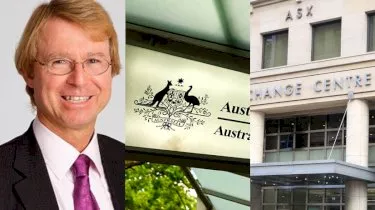Invest
More tax cuts on the way: Predictions for the federal budget
The federal government’s latest set of accounts makes one thing clear: bigger tax cuts are on the way in the next federal budget. AMP Capital chief economist Shane Oliver explores this, and what’s on for the week ahead, in his latest market update.
More tax cuts on the way: Predictions for the federal budget
The federal government’s latest set of accounts makes one thing clear: bigger tax cuts are on the way in the next federal budget. AMP Capital chief economist Shane Oliver explores this, and what’s on for the week ahead, in his latest market update.

Key developments in the last week
- Bigger tax cuts on the way in Australia in the April Budget.
The Federal Government’s Mid-Year Economic and Fiscal Outlook set aside around $3 billion a year in revenue “decisions taken but not yet announced” starting from next financial year and this presumably refers to tax cuts.
On top of this, budget data up to January shows this year’s budget tracking around $3 billion a year better than MYEFO projected and the rise in the iron ore price is likely to have added to this although it may be partly offset by a downgrade to economic growth, employment and wages assumptions for 2019-20. Overall though it looks like there is scope for around $6bn in extra fiscal stimulus in 2019-20 that would basically leave the budget projections into a surplus unchanged.

It would make sense for the Government to do this given the loss of growth momentum in the economy, but it would only be around 0.3% of GDP so a pretty small stimulus and the election would add a bit of uncertainty as to its timing.
That said this is on top of the $3bn in tax cuts already legislated from the May Budget last year. So, all up it would amount to a fiscal stimulus of around 0.5% of GDP, most of which would go to the household sector just at the time it needs it given falling house prices and a likely rise in unemployment. It won’t be enough to head off the need for RBA rate cuts, but it will help.
- Don’t panic! Panic! The Brexit fiasco.
While the rejection of a no deal Brexit was positive the margin was low, the vote was non-binding and in any case there is no majority support in Parliament for any one deal. So while the British pound hit a 9 month high in the last week, the Brexit comedy has a long way to go yet to being resolved. The best solution would be to have another referendum – which would likely see Bremain win. For investors on the other side of the world though it’s all just an entertaining sideshow having little impact on global markets (beyond the UK itself).
- Global share markets rose over the last week, helped by benign economic data.
Australian shares slipped though with consumer and financial shares down on worries about the economy. Bond yields were flat to up globally but fell in Australia with the 10-year bond yield falling back below 2 per cent for the first time since 2016 as weakening economic data adds to expectations for RBA rate cuts. While gold and copper prices slipped oil and iron ore prices rose. The Australian dollar also rose slightly as the US dollar slipped.
What’s on next week?
- In the US, expect the Fed (Wednesday) to leave interest rates on hold and indicate that the pause will continue for some time yet.
But even more significantly its likely to make some reference to moving to a framework that targets average inflation over time with the implication that it will allow a period of inflation above 2% to make up for all the years below) and there is a good chance that it will indicate a tapering in its process of balance sheet reduction (or quantitative tightening) in the second half ahead of ending it early next year. All of this is likely to be taken as dovish by investment markets.
- In Australia, expect ABS data to show a 2 per cent fall in house prices (Tuesday) for the December quarter.
This is consistent with private sector surveys and February labour force data (Thursday) to show a 5000 gain in jobs and unemployment rising to 5.1 per cent. The CBA business conditions composite PMI for March is likely to have remained weak. The minutes from the last RBA board meeting (Tuesday) will likely maintain a neutral bias on interest rates.

Investment insights
Global investment giant tips market resilience and rate cuts to continue in 2025
State Street Global Advisors has predicted ongoing interest rate cuts and economic resilience for 2025, with its forecast of a US soft landing expected to materialise. Read more

Investment insights
UK pension funds and insurers plan significant investments in renewable energy
A new survey by AlphaReal reveals that UK pension funds and insurers are looking to increase their investments across a range of renewable energy technologies over the next five years. Read more

Investment insights
Morgan Stanley executive touts benefits of long-term equity investing
Investing in high-quality companies with sustainable returns can lead to strong long-term performance, according to a senior Morgan Stanley executive. Read more

Investment insights
Diversification key to managing political risks in global markets, says deVere CEO
Political uncertainties in Europe, the UK, and the US are driving market dynamics, making diversification crucial for investors, according to Nigel Green, CEO of deVere Group. Read more

Investment insights
Diversify AI investments beyond Nvidia for long-term wealth, says deVere Group CEO
Investors should look beyond AI giants like Nvidia and diversify their investments across the wider AI ecosystem to build long-term wealth, according to Nigel Green, CEO of financial advisory and ...Read more

Investment insights
Disappointment over Apple's AI plans and political uncertainty in France weigh on markets
Investors were left unimpressed by Apple's revelations about its artificial intelligence (AI) plans at the company's Worldwide Developer Conference yesterday. Despite details about a partnership with ...Read more

Investment insights
The future of investment: Trends shaping Australia in 2024
As we look towards 2024, the Australian investment landscape is poised to undergo significant transformations driven by technological advancements, economic shifts, and evolving consumer behaviorsRead more

Investment insights
Market rally faces next test as Nvidia earnings loom amid inflation debate
Equity markets around the world celebrated last week after softer-than-expected US inflation data fueled hopes of interest rate cuts, but questions remain over whether the rally can be sustained as ...Read more

Investment insights
Global investment giant tips market resilience and rate cuts to continue in 2025
State Street Global Advisors has predicted ongoing interest rate cuts and economic resilience for 2025, with its forecast of a US soft landing expected to materialise. Read more

Investment insights
UK pension funds and insurers plan significant investments in renewable energy
A new survey by AlphaReal reveals that UK pension funds and insurers are looking to increase their investments across a range of renewable energy technologies over the next five years. Read more

Investment insights
Morgan Stanley executive touts benefits of long-term equity investing
Investing in high-quality companies with sustainable returns can lead to strong long-term performance, according to a senior Morgan Stanley executive. Read more

Investment insights
Diversification key to managing political risks in global markets, says deVere CEO
Political uncertainties in Europe, the UK, and the US are driving market dynamics, making diversification crucial for investors, according to Nigel Green, CEO of deVere Group. Read more

Investment insights
Diversify AI investments beyond Nvidia for long-term wealth, says deVere Group CEO
Investors should look beyond AI giants like Nvidia and diversify their investments across the wider AI ecosystem to build long-term wealth, according to Nigel Green, CEO of financial advisory and ...Read more

Investment insights
Disappointment over Apple's AI plans and political uncertainty in France weigh on markets
Investors were left unimpressed by Apple's revelations about its artificial intelligence (AI) plans at the company's Worldwide Developer Conference yesterday. Despite details about a partnership with ...Read more

Investment insights
The future of investment: Trends shaping Australia in 2024
As we look towards 2024, the Australian investment landscape is poised to undergo significant transformations driven by technological advancements, economic shifts, and evolving consumer behaviorsRead more

Investment insights
Market rally faces next test as Nvidia earnings loom amid inflation debate
Equity markets around the world celebrated last week after softer-than-expected US inflation data fueled hopes of interest rate cuts, but questions remain over whether the rally can be sustained as ...Read more








